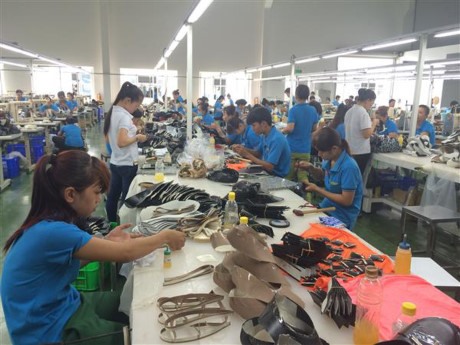
Producing shoes for export at Vien Thinh Shoes Company Limited.
The Ministry of Industry and Trade held a seminar in HCM City on April 7 to collect comments from experts and enterprises in the industry on the revised plan.
According to the revised plan’s overall objectives, the leather and footwear industry will develop at a high speed to maintain its position as one of the country’s key export industries and create more jobs with improved incomes for workers.
Implementing better corporate social responsibility and raising the number of trained labourers are other objectives of the project.
Under the revised plan, the sector’s annual production value is expected to grow by 11.62 per cent in the 2016-20 period, 8.87 per cent in the 2021-25 period and 6.04 per cent in 2026-35 period.
In addition, it would strive to achieve an annual export growth rate of 10-15 per cent in the 2016-20 period, 8-9 per cent in the 2021-25 period and 4-5 per cent in the 2026-35 period, with export revenues expected to reach $24-26 billion by 2020, $35-38 billion by 2025 and $50-60 billion by 2035.
It also targets to raise the local content rate in footwear products to 45 per cent by 2020, 47 per cent by 2025 and 55 per cent by 2035.
Assessing the implementation of the master plan for Viet Nam’s leather and footwear industry development until 2020 with a vision to 2025, which was approved in 2010, Nguyen Manh Khoi, Deputy Director of the Leather and Footwear Research Institute, said after five years of executing the plan, the Vietnamese leather and footwear industry has developed strongly and made positive contributions to the country’s economy.
Some targets set out in the master plan have been implemented quite well, such as basically completing the equitisation of State-owned enterprises, and forming joint ventures and co-operating with all economic sectors, which created conditions for businesses in the sector to thrive.
The sector has invested in upgrading equipment, building new large-scale plants with advanced equipment and technology to raise the production capacity for the sector, he said.
Most of the companies have applied a management system in accordance with ISO 9000, ISO 14000, SA 8000, as well as perform corporate social responsibility.
But some targets have not been accomplished, he said.
For instance, the local content rate in products remained low at about 35-40 per cent, he said, adding that the number of enterprises applying automation in designing and developing products is also modest.
Other targets, including the transformation of product structure and establishing a specialised industrial zone for the sector, especially for leather tanning, have not been done, he said.
Delegates at the seminar said demand for raw materials would also surge strongly, and so if supporting industry is not developed in the coming years, the industry would have to depend greatly on imports, which would make it hard to accomplish its targets.
There are some 1,700 enterprises in the sector in Viet Nam, of which 800 are large. Foreign-invested enterprises account for 80 per cent of the sector’s exports.
Leather and footwear products are among Viet Nam’s key export items, with exports reaching $16.2 billion last year, accounting for 10 per cent of the country’s total exports.
They are expected to top $17.88 billion this year.
The country is the third largest footwear maker and second largest exporter in the world.
VNS